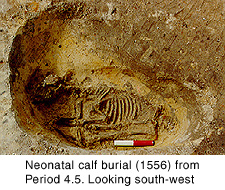
Figure 31a
Burials, human and animal, were generally distributed sparsely across the site. There were four human burials. The only complete inhumation (3004), in grave cut 3005, was from Trench 3. It was probably interred in the early Roman period, perhaps before the ditch system had been established in this area in the later 2nd century. The skeleton was flexed, with the head to south, facing west. The individual was a mature male, probably between 30 and 40 years of age. The right fibula had been fractured but had healed well and remodelled extensively. Both tibiae had unusual pitted striations on their surfaces associated with a chronic, low-level inflammatory response. Small localised lesions may represent the occurrence of leg sores. Parts of the skeleton, notably the skull, had suffered damage from medieval ploughing.
The other inhumation (125) was recovered from Trench E, approximately 9.0m north-west of Building D. It was in a shallow pit about 1.0m square (124). Around the edges of the cut were vertically set nails, points uppermost. Many had remains of wood grain preserved in their corrosion products, which suggests that the nails had held together a wooden box which contained the burial. Only a skull and a fragment of limb bone were found. In any case, such a small grave could not have accommodated a complete, intact inhumation. It is likely that this was an incomplete burial, perhaps derived from an earlier burial that had subsequently been disturbed and reburied with a degree of care.
There were two human cremations. 1385 was found in a jar, which had been placed in a small cut (1400). It was probably contemporary with Building C, which lay 5.0m to the east. The jar was early Roman in date, but the burial is thought to date to the late 2nd century or early 3rd century. The pieces of bone were all calcined and heavily fragmented, and many had been crushed to dust. No indication of sex, age at death, or pathology could be recognised. There was no evidence of any other mammal species present, although the fragmentary nature of the cremation does not preclude this possibility. The second cremation (1327) was found around 2.0m north of Building D, in a square, shallow cut (1333). There was no evidence that it had been buried in a container. Most of the bone fragments were calcined, but they were not burnt to such a high degree as those in the other cremation. Several tooth roots and a phalanx were identified. It was not possible to determine the sex, or age at death.
Inhumation 1556, the skeleton of a neonatal calf, was found in the base of a small but moderately deep cut (1536) (Fig.31a). Although the stratigraphic relationship with adjacent features is unclear due to truncation by medieval ploughing, it is thought that this burial was originally positioned beneath the south wall of Building C.

Figure 31a
Six cremated animals were found on the site. Burial 1500 was in a small cut (1522) towards the east side of Trench 1 (Period 4.5). It was probably deposited beneath the west wall of Building C. The many small bone fragments exhibited varying degrees of burning (blackened to calcined), which indicates that the material had been subjected to a range of temperatures.
Burial 2100 of Period 4.3 was in a very small cut (2103), about 16.0m south of the Roman road. The ash and charcoal fill included many small burnt bone fragments which could not be identified.
Three burials were found within 4.0m of each other, immediately south of the Period 4.7 fence that formed the southern limit of the roadside properties for a time during the later 3rd century. Many small fragments of burnt bone (1119) were found in the base of a small cut (1120). This burial was similar in character to 2100. The second, cut 1559, contained sand, charcoal and many fragments of burnt bone (1255).
The most intriguing burial of the three was in cut 1101. Incorporated in the sandy fill (1094) were two deposits of bone. In the upper part of the fill was a sheep-sized cremated individual; in the base of the cut was a partially cremated individual, probably a caprine, which was apparently articulated. The cut also contained much charcoal, and some burnt oyster shells and limestone fragments. It seems that this was a ritual involving the deliberate burial of two cremated animals.
© Internet Archaeology
URL: http://intarch.ac.uk/journal/issue9/brough/burials.html
Last updated: Tue Nov 28 2000